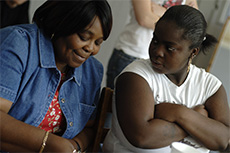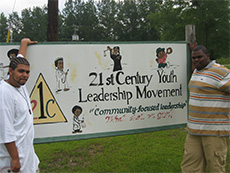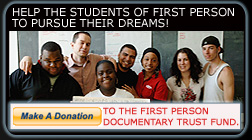Production Model
Production of First Person is guided by three main principles.

- Since the beginning of production, Macho and the rest of the First Person students have been turning handheld videocameras on themselves, their worlds, and the crew.
First, we believe that no one can tell young people’s stories better than they can. First Person is dedicated to bringing forth their voices, and it has been amazing to watch these students develop as young men and women, as video diarists, and as individuals with important voices capable of powerful expression and analysis. They have been courageous and candid in sharing what the path to college looks like through their eyes and in offering revealing glimpses into their internal lives.

- Shalisa and her Grandmother confer during a First Person planning meeting.
First Person students also make their voices heard through a consensus-based decision-making model. Through regular production meetings that include students and their families, as well as crew, everyone has remained engaged in deciding where we shoot, when we shoot, and what we shoot. Kurtis put it best: “The students of First Person make [the project] a success.” Students determine how to put ideas into effect: where is the best place to film and what topics should be used. People finally get to hear what we think about things in school and in the neighborhood, and we like that.�

- Director Benjamin Herold leads a First Person planning meeting.
Second, it is adults’ responsibility to provide young people with both a structure for telling their stories and with a powerful medium for being heard. As Director, Benjamin Herold has shaped First Person with his belief that young people must be able to effectively navigate between their home, school, and neighborhood worlds in order to achieve both personal and academic success. During production planning, during interviews, and in supporting creation of video diaries, he has pushed these young people to reflect on their own experiences across these worlds. By merging professionally-shot footage with student-shot video diaries, First Person then provides these young people with a payoff for their courage, offering them the unique opportunity to be a part of a broadcast-quality production as both subject and cinematographer.

- Macho and Steve pose following their presentation at the 21st Century Youth Leadership Movement Summer Camp in Selma, Alabama.
Third, we gotta reach somebody. Documentary is only powerful to the extent that it inspires people to feel, believe, and do. Together, we have identified three audiences we hope to reach: urban middle and high school students, who need to see their own experiences reflected in discussions about college; educational professionals, who need to better understand urban public high school students in order to better serve them; and the general public, who need to be inspired to step outside of the limits of what they know in search of something better. To these ends, First Person is not just a movie. It is an interactive, research-based, multimedia project that supports a critical advocacy agenda: increasing college access for urban public high school students. To date, we have reached sixth graders in North Philly, prospective teachers on the Main Line, youth activists in Alabama, community audiences throughout the region, and many others with our project. We can’t wait to reach you next.

